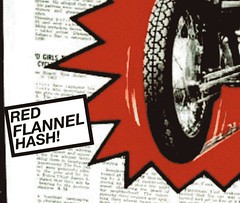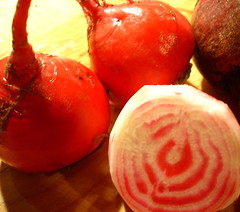Hash Fiend 1, or Frying the Flannel
 fig. a: red flannel
fig. a: red flannel
Lately, I’ve been cooking up a fair bit of hash. No need to worry, though. This hasn’t led to me rereading Steppenwolf, or resurrecting my old Jim “An American Poet” Morrison poster, or illuminating my room with black lights and lava lamps, and it’s not part of some kind of mid-life crisis. At least, I don’t think it is.
The hash I’m talking about is good old-fashioned hash-house hash, the kind of hash that consists of the combination of diced meat or fish, onion, and some root vegetables--usually potatoes, plus carrots, beets, or turnips. The kind of hash that was a North American staple for generations. The kind of hash that was much more than just a breakfast dish and that was largely displaced by fast food (especially the hamburger) and changing tastes in the early- to mid-twentieth century.
Now, as you'll see in subsequent posts, I've been making a whole host of hashes over the last couple months, but today I want to begin this discussion by looking at a colorful little gem called Red Flannel Hash.
I know, I know: sounds like the name of a grunge band circa 1992. Can't you just picture the poster?
 fig. b: Live! At the Hi-Hat!
fig. b: Live! At the Hi-Hat!
 fig. c: Live! At the Hi-Hat! (detail)
fig. c: Live! At the Hi-Hat! (detail)
[As it turns out, there is a band that goes by the name of Red Flannel Hash, but my gut feeling tells me they've never shared a bill with either Mudhoney or Tad, let alone fIREHOSE. Check 'em out.]
Anyway, as I was saying, this concoction has more to do with the Northeast than with the Northwest. All indications point to the fact that the dish originated in New England--"authentic" versions of the dish are often described as Yankee Red Flannel Hash, and most of the tall tales that surround the dish's origins are set in lumber camps in Maine, or New Hampshire, or Vermont.
Look Red Flannel Hash up and you'll also find that it's one of those dishes that provokes controversy. We're not talking barbecue-size controversy, or pizza-size controversy, but controversy nonetheless. Everyone agrees that beets should be front and center, the main question is whether or not corned beef should also be a part of the ensemble. And what you find is that some of the most vocal experts on the matter, people who take the culinary foodways of the Northeast very seriously indeed, insist that red flannel should be corned beef-free. Not meat-free, mind you, but corned beef-free. According to this school, the combination of beets, potatoes, onions, and corned beef adds up to something altogether different: a Calico Hash. In a true Red Flannel Hash, the beets are the stars, and they have no fear of being upstaged. This doesn't mean that Red Flannel Hash is meatless. As with most other hashes, tradition says that bacon fat plays an important supporting role, and it's not uncommon to find some actual bacon in the cast, as well.* [Have an opinion on these matters? By all means, chime in.]
Our own version is one we’ve extrapolated from a few different sources. If you’re already a Red Flannel Hash fiend, you might take exception to this or that element, but this AEB version has all the essential elements--the onions, the beets, and the potatoes--and it makes for one fine hash. It's become one of our very favorite breakfasts here at AEB HQ, especially at this time of year, when beets of all types (red, golden, chioggia) are plentiful.
 fig. c: beets, candy-striped and otherwise
fig. c: beets, candy-striped and otherwise
I’ve read recipes for Red Flannel Hash that don’t involve boiling your vegetables--some insist on steaming the vegetables instead--but boiled vegetables are an important part of most true hashes, and we’ve been pretty happy (ecstatic, actually) with the results here.
If you’re a vegetarian, you could easily omit the bacon and replace the bacon fat with a tablespoon of oil, and you’d wind up with a perfectly satisfying Red Flannel Hash, but there is something to be said about the marriage of those beets and that smoky bacon flavor, and it pays to hunt down top quality beets and bacon to match. If you’re a vegan, you could omit both the bacon and the whipping cream, and you’d still be left with a perfectly acceptable (and delicious!) hash--the cream is optional, but (highly) recommended. If you’re a raw foodist, though, I’m sorry, this isn’t the dish for you. It’s just not a Red Flannel Hash if the flannel hasn’t been fried.
AEB Red Flannel Hash
2-3 strips of smoky bacon
5 small beets (mixed varieties, if available), peeled and diced
2 medium potatoes, peeled and diced
1 small carrot, washed and diced
1 small parsnip, washed and diced
salt and black pepper to taste
1 small onion, peeled and diced
1 clove garlic, minced
1-2 tbsp parsley, minced
1/4 cup whipping cream (optional, but recommended)
sour cream (optional)
Add the diced beets, potatoes, carrots, and parsnip to a small pot, and add just enough water to cover the vegetables. Salt the water to taste and bring the water to a boil. Turn down the heat and simmer the vegetables for about 10-12 minutes, or until just tender. Drain the vegetables, making sure to reserve the liquid. [This broth is essentially a clear borscht. Adjust the seasoning, and you have yourself a great light meal.]
Meanwhile, fry the bacon in a frying pan or a cast-iron skillet until crispy. Remove the bacon with a slotted spoon or slotted spatula, reserving the bacon fat. Mince the bacon and set aside.
Fry the onion in the bacon fat over medium heat until the onions have softened and have turned translucent, about 5-10 minutes. Add the vegetables and sauté for a few minutes. Add the garlic, the parsley, and the reserved bacon and sauté for another minute. Add the cream, adjust the seasoning, and turn up the heat. Many hash fiends will tell you that you should turn the heat up to high and fry the hell out of it, so that the hash forms a blackened crust. This hash fiend will tell you that I’ve tried making my hash a number of ways, and that I prefer my Red Flannel Hash with the golden brown crust that one gets when one cooks the hash over medium to medium-high heat for a few minutes per side.
Serve a generous heap of the red flannel hash on each plate, with a poached egg or two perched on top, and maybe even a dollop of real sour cream.
Serves 2-4, depending on appetite/enthusiasm.
[major inspiration provided by John Thorne's Serious Pig]
aj
*Okay, enough with the extended metaphor.












